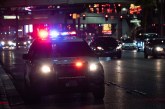 Judge Will Hear Evidence to See if Public Records Act Compels University to Release Officer Names –
Judge Will Hear Evidence to See if Public Records Act Compels University to Release Officer Names –
When the University of California was attempting to release the Reynoso Task Force and the Kroll Reports back in April, they ultimately agreed to a deal where they would withhold the names of all police officers, except for Former Chief Annette Spicuzza and Lt. John Pike, whose roles and names were well known.
They did so in the interest of expediting the release of the reports in a timely manner to allow the public to gain insight into the events on November 18, 2011. The judge believed that there was enough threat to the safety of additional officers, after being presented with evidence that Lt. Pike suffered a substantial amount of harassment in the days immediately following the November 18 pepper spraying incident, to keep the temporary injunction on their release.
On Tuesday, June 26, attorneys for the Los Angeles Times and the Sacramento Bee will be petitioning the court in Alameda County to release all of the names.
In their petition, they argue that the agency (the University of California) and the union “bears a heavy burden to establish with admissible evidence a public interest in nondisclosure that clearly outweighs the public interest in disclosure.”
They argue that neither the Regents nor the Police Officers Association (FUPOA) offer any “evidence about supposed safety threats from any of the officers whose names were redacted from the report (the “Reynoso Task Force Report”) about the November 18, 2011 incident when UC police pepper sprayed sitting student demonstrators on the campus quad.”
They argue this absence of evidence means neither party has “satisfied their burden of showing a clear overbalance on the side of confidentiality necessary to override the public’s constitutionally protected right to learn the identities of the officers involved in the incident, captured on YouTube videos circulated around the world.”
They argue that the circumstance has materially changed since the court issued the preliminary injunction. “FUPOA offered no evidence that the officers other than Lt. Pike faced any safety threats, and Lt. Pike’s declaration showed at most harassment in the days after the November incident, not actual credible threats.”
Furthermore, they argue that in March and April, “the Davis Wiki and Davis Vanguard web sites publicly identified the officers whose names were withheld from the Reynoso Task Force Report, including Officer Alexander Lee, who also pepper sprayed students.”
They argue that the public and anyone who might “supposedly” wish to harm the officers already has access to their names and can tie them to the contents of the Reynoso task Force report.
They argue, therefore, that there is no public interest in non-disclosure of the officers’ names on the basis of safety.
On the contrary, they argue, “Balanced against the de minimis interest in nondisclosure is the profound public interest in ensuring that officers, who by statute must wear name tags on their uniforms, do not remain anonymous when they exercise force against sitting student demonstrators and later make controversial comments about their use of force against protesters.”
Lt. Pike, they argue, did not act alone and there were “dozens of errors by officers detailed in the Reynoso Trask Force Report” which they argue “reinforces the public’s right to officially confirm for completeness and authenticity the identities of all of the officers involved in the UC Davis debacle, especially considering that protests continue on campuses against budget cutbacks and tuition hikes, protests in which these same officers will be expected to do the public’s business in maintaining peace and safety.”
“This Public Records Act case requires a more exacting test for withholding documents than the preliminary injunction balancing-of-harms test used by the Court in Pike,” the attorneys argue.
Government Code Section 6255, which is the code that contains the public records act, a code not analyzed in the previous decision, states that “the balancing test is heavily weighted in favor of public disclosure. Records may only be withheld if the agency satisfies its burden of establishing a public interest in nondisclosure that clearly outweighs the public interest in disclosure.”
Instead they argue, “To meet the agency’s burden, the California Supreme Court and Courts of Appeal have repeatedly explained that the public agency has to produce evidence substantiating safety threats to the officers that demonstrated a ‘clear overbalance’ on the side of confidentiality.”
These threats, they argue, must be specific and the attorneys must show numerous examples of cases where the court rejected claims about hostility to uniformed officers or general claims about safety.
In fact, they argue that both the regents and FUPOA “now twice had the opportunity to present evidence from the officers whose names were withheld from the Reynoso Task Force Report. However, three months ago in Pike neither The Regents nor FUPOA submitted any such evidence from the officers whose names were redacted showing a credible safety threat to the other officers involved in the pepper spray incident.”
The attorneys argue, “If no such showing was even offered three months ago as to the other officers who worked with Lt. Pike, it is obvious that some seven months after the incident (and while the officers’ names have become publicly known), these officers face no credible safety threats if their names are confirmed through this Court’s order.”
Later they disagree with FUPOA’s claims “that the continued public interest in access to the names of the officers who planned and executed the operation that led to the pepper spraying means that the officers face an ongoing safety threat.”
The attorney for the Bee and the Times argues, on the contrary, “This is rote speculation. Specific evidence of a safety threat cannot be shown by mere public interest in the information. FUPOA provides no who, what, when, where, how, or why as to any specific safety threats supposedly faced by these officers. The mere assertion of possible endangerment based on ongoing public interest in an incident does not and cannot override the public’s right of access to this important information.”
The attorneys also argue that Pitchess statues do not apply to the names of the officers in the Reynoso Task Force Report. They cite case law that shows the Supreme Court of California ruled that Pitchess statutes fail to bar the disclosure of all information concerning officers, but rather “only cover specific, limited categories of information; M., the identity of undercover officers, is not at issue here. Narrowly construing the Pitchess statutes, the Court made clear that neither the statutory language nor the legislative history indicated any intent to render law enforcement officer identities confidential.”
The attorneys make the argument with regard to safety that we have made for several months now. The harassment of Lt. Pike, on whose declaration the entire case seems to rest, occurred seven months ago when anger and emotions were at a high level.
Since then, the situation has calmed down. The Vanguard released two names without incident.
Back in April, ACLU Staff Attorney Michael Risher argued that the order was overly-broad. Given the length of time that has passed since the incident, he is not sure that new revelations would bring forth the same level of harassment that Lt. Pike experienced in the days immediately following the highly-publicized and volatile incident.
“It’s not clear to me that releasing the names of other officers that weren’t involved in such a notorious way of officer Pike…or didn’t pepper spray anyone but were just witnesses, would subject them to any sort of harassment, particularly now months later after people’s passions have cooled,” he said.
Terry Francke, director of CalAware, told the Vanguard in April that he believes that a good case can be made at this point that the names of officers would not be exempt, but that would depend largely on how a judge interpreted threats against Officer Pike and whether a judge would rule that, given the passage of time and the calming of tensions, a clear threat to the safety of the officers outweighed the public’s right to know the names of the officers.
—David M. Greenwald reporting






[quote]They argue that neither the Regents nor the Police Officers Association (FUPOA) offer any “evidence about supposed safety threats from any of the officers whose names were redacted from the report (the “Reynoso Task Force Report”) about the November 18, 2011 incident when UC police pepper sprayed sitting student demonstrators on the campus quad.”[/quote]
There is no evidence of threats [i][b]bc the names have not been released[/b][/i]. But there is evidence that Lt. Pike was threatened – so I don’t think it is a stretch to think there would be threats against any other officer involved in this incident.
I think an argument can also be made that because time has passed and the Reynoso report has been released, how newsworthy are the other officers’ names juxtaposed against potential safety issues? It will be interesting to see which side a judge comes down on this one.
” But there is evidence that Lt. Pike was threatened – so I don’t think it is a stretch to think there would be threats against any other officer involved in this incident.”
That’s not the standard here. They have to show that there are in fact threats and they would have to show that there will be threats.
They have access apparently to Pike’s declaration and we don’t, so I assume they can sort out whether these were actual threats or simply harassment and when the last one was.
I think seven months after the fact it is unlikely that any real danger exists. One of the point we have made is that Alexander Lee was a rookie officer, following (granted unlawful) orders and therefore played a smaller role than Pike, it seems unlikely that he would suffer threats from further disclosure.
[quote]They have access apparently to Pike’s declaration and we don’t, so I assume they can sort out whether these were actual threats or simply harassment and when the last one was. [/quote]
Seems to me the court thought there was evidence of credible threats…
“Seems to me the court thought there was evidence of credible threats…”
Lower standard for preliminary injunction versus denial of CPRA
[quote]so I assume they can sort out whether these were actual threats or simply harassment and when the last one was. [/quote]Hmmmm… and yet, it appears this is not the standard applied to the significance of “the noose”… double standard?
Good point hpierce, I was thinking the same thing.
I have a much more basic objection to keeping the names of officers involved in any given action from the public.
These are “public” officers. We pay their salaries. They are required to wear their badges when performing their duties. I feel very strongly that the public has the right to know their identity.
An analogy from my own field. As physicians and surgeons, we are obligated to wear our identity badges when performing our clinical duties. This is as it should be. My patient’s, whether or not I have met them previously ,have a right to know who I am, and patient’s who make seek out my care in the future have a right to know my identity and whether or not there are actions pending at the level of the State Medical Board against me. I have been personally threatened three times in my career and I will still stand behind a patient’s right to know the identity of a doctor, and the public’s right to know the identity of a police officer.
At this point, exactly what is the purpose/newsworthiness of such information?
Fair question. I talked to one of the attorneys to make sure they knew we already reported on the names of the officers. The basic answer is that they believe this information should have been disclosed legally by the university, and they believe that there is an issue of open government and accountability. You may disagree with them on these points, but I tend to think they are right for many of the reasons mentioned above.
Elaine
[quote]At this point, exactly what is the purpose/newsworthiness of such information?[/quote]
I agree with David’s response. And for me, as a frequent peaceful protester in the past, there is another aspect which you may discount, but which is very real to me.
I am much more prudent now than I was when I was younger. I can see a value very close to that which I can see for knowing your physician as I posted above. If I know the names of officers involved in what I consider to be the use of excessive force, I can use this as very real information about where I might choose to mount a protest safely in the future. Several posters here have made the generalization that all protesters want to get arrested and provoke the police into violent action. I can guarantee you from direct personal experience, that this is not true of all protesters and that some of us have a strong preference for and would only participate in protests which are non violent and in which we perceive there to be minimal risk of a police over reaction or use of excessive force. This would mean avoiding locations under the auspices of police with a record of questionable use of excessive force.
Don’t agree, so we’ll have to agree to disagree. Frankly at this point, to release the names of the officers seems to me, and this is just me speaking, to be nothing more than the news media trying to create a story on a slow news day. I would much prefer to move on – the pepper spray incident is done and over with, the university has begun implementing the necessary changes. I see no good purpose being served by dwelling on this incident ad nauseum…
Elaine
I don’t mind agreeing to disagree, but I do have an honest question.
Do you not think the names of physicians who do not perform their duties in an appropriate manner should be listed for the public to made aware of ? We are reported to the medical board for wrongful actions. Do you believe that this is the right course of action ?
If you do, what do you see as the difference here ?
[quote]Do you not think the names of physicians who do not perform their duties in an appropriate manner should be listed for the public to made aware of ? We are reported to the medical board for wrongful actions. Do you believe that this is the right course of action ? [/quote]
It has not been adjudicated that these officers did anything wrong yet. If there is an adjudication that they were in the wrong, THAT IS THE TIME TO PUBLISH THEIR NAMES…
Elaine
Ok, I now see your point. And we are back to agreeing to disagree ; )
I’ve been to court twice to support the students & professor. My own father was a cop but I find the cops’ behavior that day just despicable & against everything my dad stood for. I have also been the victim of agressive police tactics, including, but not limited to, being handcuffed. My family has lived in many places. The Dixon and Davis law enforcement are the worst of any place we’ve lived. I have never been arrested, but I’ve been treated extremely disrespectfully. Anyone reading this comment should take note:the statute of limitations for police misconduct in our state is only 2 years. By the time I had recovered enough from my psychological trauma to face the cops, it was too late for me. God Bless you, Davis Dozen. God bless America, too.